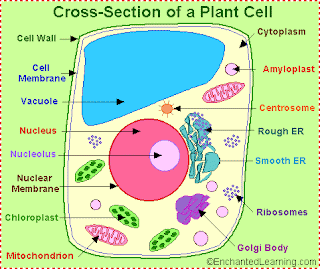Plant cells
Plant cells are eukaryotic cells that differ in several key aspects from thecells of other eukaryotic organisms. Their distinctive features include:
- A large central vacuole, a water-filled volume enclosed by a membrane known as the tonoplast[1][2] that maintains the cell's turgor, controls movement of molecules between the cytosol and sap, stores useful material and digests waste proteins and organelles.
- A cell wall composed of cellulose and hemicellulose, pectin and in many cases lignin, is secreted by the protoplast on the outside of thecell membrane. This contrasts with the cell walls of fungi (which are made of chitin), and of bacteria, which are made of peptidoglycan.
- Specialized cell-to-cell communication pathways known asplasmodesmata,[3] pores in the primary cell wall through which theplasmalemma and endoplasmic reticulum[4] of adjacent cells are continuous.
- Plastids, the most notable being the chloroplast, which containschlorophyll, a green-colored pigment that absorbs sunlight, and allows the plant to make its own food in the process known asphotosynthesis. Other types of plastids are the amyloplasts, specialized for starch storage, elaioplasts specialized for fat storage, and chromoplasts specialized for synthesis and storage of pigments. As in mitochondria, which have a genome encoding 37 genes,[5] plastids have their own genomes of about 100–120 unique genes[6] and, it is presumed, arose as prokaryoticendosymbionts living in the cells of an early eukaryotic ancestor of the land plants and algae.[7]
- Cell division by construction of a phragmoplast as a template for building a cell plate late in cytokinesis is characteristic of land plants and a few groups of algae, notably the Charophytes[8] and the Order Trentepohliales[9]
- The sperm of bryophytes and pteridophytes, Cycads and Ginkgo have flagella[10] similar to those in animals,[11][12] but higher plants, (including Gymnosperms and flowering plants) lack the flagellae and centrioles[13] that are present in animal cells.



